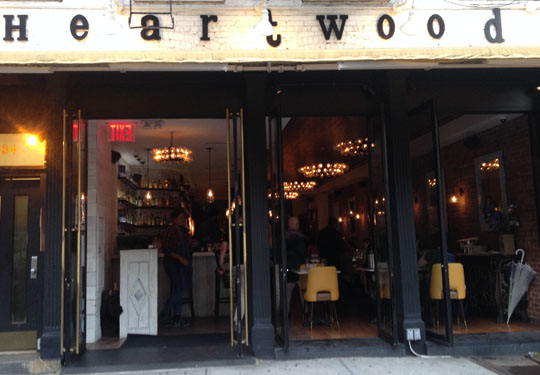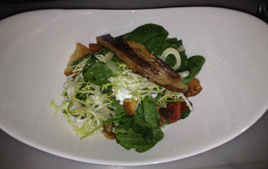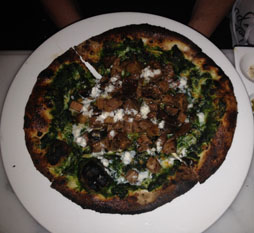
Note: Well, that was fast. Four months in, chef Scott Bryan left the restaurant to take over at Corvo Bianco on the Upper West Side. That’s not exactly a hotspot, so the difference of opinion between Bryan and the owners here must have been substantial. As noted below, it seemed to us that there was a disconnect between Bryan’s inexpensive casual menu here and the deep wine list. Alas, the new chef at Bacchanal, couldn’t rescue the concept either, and the restaurant closed at the end of 2015.
*
 Years from now, perhaps the early twenty-teens will be called the VeriCru diaspora. Veritas and Cru, perhaps the two best wine restaurants the city has seen, both expired in 2009–10, victims of the Great Recession.
Years from now, perhaps the early twenty-teens will be called the VeriCru diaspora. Veritas and Cru, perhaps the two best wine restaurants the city has seen, both expired in 2009–10, victims of the Great Recession.
(For the history buffs out there, I do realize that Veritas re-modeled and somehow soldiered on until 2013. I prefer to remember Veritas as it was conceived, not the watered-down replacement that tried and failed to replace it.)
Since then, we’ve seen openings like Pearl & Ash and Charlie Bird, where great (but not “VeriCru” epic) wine lists pair with good (but not great) food in drastically pared-down rooms. To me, it seems odd to pair a $250 Brunello with a $29 roast chicken, in a room where you can barely hear yourself talk. But if you want it, you can have it. Veritas and Cru had it all; these places do not.
Welcome to Bacchanal, the latest entry in the genre. The pedigree is obvious, starting with the chef, Scott Bryan, who opened Veritas (lasted eight years there), consulted a bit, spent five years at the mediocre Apiary, and is now back in his element.
 Owner Peter Poulakakos has a stable of Financial District restaurants, anchored by Harry’s at Hanover Square and the more recent Vintry Wine & Whisky, where the reserve list goes as high as a 1945 Château Haut-Brion for $9,975. No doubt Poulakakos borrowed from those superb lists to open Bacchanal, as it’s almost unheard of to build such a cellar from scratch at an untried restaurant.
Owner Peter Poulakakos has a stable of Financial District restaurants, anchored by Harry’s at Hanover Square and the more recent Vintry Wine & Whisky, where the reserve list goes as high as a 1945 Château Haut-Brion for $9,975. No doubt Poulakakos borrowed from those superb lists to open Bacchanal, as it’s almost unheard of to build such a cellar from scratch at an untried restaurant.
On a wine and spirits list that runs to 40 pages, you’ve got 1970 Domaine de la Romanée-Conti ($9,125), 1978 Château Pétrus ($2,900), and 1982 Château Mouton Rothschild ($1,950), to name a few. For those who don’t want to spend a mortgage payment on dinner, there are many excellent offerings in the $45–60 range. But how can you not splurge, at least a little bit? A 2001 Château Moulinet, which the sommelier decanted, was well worth the tarrif at $75.
 The knock on Scott Bryan at Veritas, was that the food never approached the wine list’s pyrotechnics. It was quietly competent and seldom disappointed, but it never left you with enduring memories, the way the wine did. He has built a similar menu here. It is surprisingly affordable, with no entrée more expensive than a $26 steak.
The knock on Scott Bryan at Veritas, was that the food never approached the wine list’s pyrotechnics. It was quietly competent and seldom disappointed, but it never left you with enduring memories, the way the wine did. He has built a similar menu here. It is surprisingly affordable, with no entrée more expensive than a $26 steak.
I am still left with the question that left me perplexed at Charlie Bird and Pearl & Ash: who is ordering three- and four-figure wine bottles, but demands a food menu that is practically budget-priced by today’s standards? Where’s the 28 dry-aged prime ribeye that Harry’s Steak sells for $48.
On paper, the food doesn’t exactly set the pulse racing. Listen to this list of entrées: pasta, ricotta agnolotti, risotto, chicken, codfish, salmon, skirt steak. As he did at Veritas, Bryan executes all of this with cool precision that makes it worthwhile, especially if the prices remain as low as they are now. If the food doesn’t get in the wine list’s way, it has done its job.


An Escarole Salad ($10; above left) wasn’t as blurry in real life as my lousy photo, but it was exceedingly pedestrian, with an anchovy vinaigrette that barely registered. Why not charge a couple of bucks more, and give us real anchovies? But Bryan can still cook. A Chilled Corn Velouté ($10; above right) was a soup of astonishing clarity, drizzled with roasted poblanos, sweet tomatoes, and basil.


Both entrées were wonderful, bearing in mind the price point: Atlantic Codfish ($26; above left) with white bean purée, manila clams, roasted garlic, and parsley; Roasted Chicken ($22; above right) with polenta, chanterelles, madeira, and tarragon.
 Dessert was a delightful Peach Tarte Tatin ($10; left) with créme frâiche ice cream and caramel.
Dessert was a delightful Peach Tarte Tatin ($10; left) with créme frâiche ice cream and caramel.
Bacchanal occupies the southern frontier on the new Bowery, with its own street entrance in the boutique Sohotel. It is a more polished restaurant than Charlie Bird or Pearl & Ash, but like those establishments, it has a distinctly downtown vibe. Low ceilings and brick walls ensure a punishing sound level. My wife and I had to shout at each other all evening, and we were seated at a two-top in a corner, with no one on either side of us.
The well-executed food and excellent wine list are somewhat undermined by the service, which was a bit slow. The restaurant was close to full on a Wednesday evening.
It will be interesting to see how Bacchanal and other restaurants of the VeriCru diaspora evolve. If you want vast wine lists without paying three-star prices for the food, these restaurants are the places where you find them. But such a large room is hardly the place where I would contemplate a three-figure Brunello. The chef does a thoroughly professional job, especially at the absurdly low price point. You have to wonder how the clash between such luxurious wine and the quotidian surroundings will eventually be settled.
Bacchanal (146 Bowery at Broome Street, Soho)
Food: Casual American, mostly well executed at a surprisingly low price point
Service: At times slow, but otherwise good
Ambiance: A punishingly loud, low-ceilinged room
Rating: ★★
 Monday, July 28, 2014 at 06:04AM
Monday, July 28, 2014 at 06:04AM 
 The Village Voice wrote recently of a “Mexican Food Moment” in New York City, including The Black Ant (La Hormiga Negra), a new restaurant in the East Village from the same folks behind Ofrenda across town.
The Village Voice wrote recently of a “Mexican Food Moment” in New York City, including The Black Ant (La Hormiga Negra), a new restaurant in the East Village from the same folks behind Ofrenda across town. True to the name, there are a number of dishes with dehydrated edible insects shipped from Mexico: a guacamole made with ant salt; a tortilla topped with fried grasshoppers; a side order of crickets. Ant salt even appears in several of the cocktails. Several bloggers have reviewed and photographed these items (here, here, here). We weren’t about to go near them.
True to the name, there are a number of dishes with dehydrated edible insects shipped from Mexico: a guacamole made with ant salt; a tortilla topped with fried grasshoppers; a side order of crickets. Ant salt even appears in several of the cocktails. Several bloggers have reviewed and photographed these items (here, here, here). We weren’t about to go near them.









































